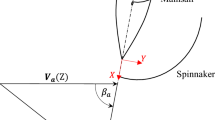Abstract
The results of the design analysis for a sailing yacht’s hull and sails are reported. The results were used to confirm the design of a 30 ft long sloop, which was planned, designed, and built in Korea for the first time in history. Flows around a sailing yacht above and under the free surface were analyzed separately using both computational and experimental methods. For the underwater flow analysis, turbulent flow simulations with and without free surface wave effects were carried out for the canoe hull with keel/rudder. The computed drag and side forces on the hull model were compared with the measurement data obtained from the towing tank experiments. In order to assess the sail performance, another set of computations was carried out for the flow around a sail system composed of main and jib sails with a mast. The present study demonstrates that, for the design analysis of a sailing yacht, computational fluid dynamics techniques can be utilized with a reasonable level of confidence.























Similar content being viewed by others
References
Larsson L, Eliasson RE (2000) Principles of yacht design, 2nd edn. International Marine, Camden
Rosen BS, Laiosa JP, Davis WH Jr. (2000) CFD design studies for America’s Cup 2000 (AIAA Paper 2000-4339). In: Proc 18th AIAA Applied Aerodynamics Conf and Exhibit, Denver, CO, 14–17 August 2000
Akimoto H, Miyata H (2002) Finite-volume simulation method to predict the performance of a sailing boat. J Mar Sci Technol 17(1):31–42
Jasak H (2009) OpenFOAM: open source CFD in research and industry. Int J Nav Archit Ocean Eng 1(2):89–94
DeBord F Jr, Reichel J, Rosen B, Fassardi C (2002) Design optimization for the International America’s Cup Class. In: Trans SNAME Annual Meeting, Boston, MA, 25–28 September 2002
Yoo JH, Kim HT (2006) Computational and experimental study on performance of sails of a yacht. Ocean Eng 33(10):1322–1342
Yoo JH, Van SH, Ahn HS, Kim J, Kim SH (2005) Development of 30 feet sailing yacht and performance predictions. J Soc Nav Archit Korea 42(1):34–42 (in Korean)
Yoo JH, Ahn HS (2005) Experimental study on the hydrodynamic forces of 30 feet sailing yacht. J Soc Nav Archit Korea 42(3):233–240 (in Korean)
Yang J, Rhee SH, Kim H (2009) Propulsive performance of a tanker full form in damaged conditions. Ocean Eng 36(2):133–144
Acknowledgments
The present study was supported by the Ministry of Knowledge Economy (MKE) through the Regional Innovation Center and by the Ministry of Education, Science and Technology (MEST) through NRF Grant No. 2009-0087863. The fourth author was separately supported by MEST through a World Class University project (R32-10161) and the Multi-phenomena CFD Research Center (NRF Grant No. 2009-0083510).
Author information
Authors and Affiliations
Corresponding author
About this article
Cite this article
Kim, WJ., Yoo, J., Chen, Z. et al. Hydro- and aerodynamic analysis for the design of a sailing yacht. J Mar Sci Technol 15, 230–241 (2010). https://doi.org/10.1007/s00773-010-0088-8
Received:
Accepted:
Published:
Issue Date:
DOI: https://doi.org/10.1007/s00773-010-0088-8




